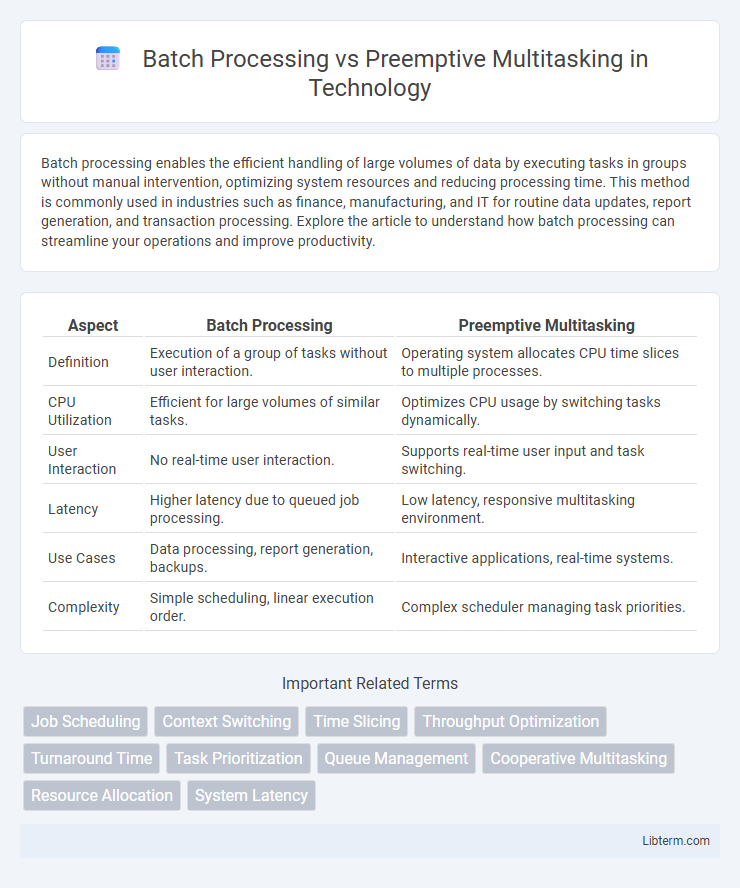Batch processing enables the efficient handling of large volumes of data by executing tasks in groups without manual intervention, optimizing system resources and reducing processing time. This method is commonly used in industries such as finance, manufacturing, and IT for routine data updates, report generation, and transaction processing. Explore the article to understand how batch processing can streamline your operations and improve productivity.
Table of Comparison
| Aspect | Batch Processing | Preemptive Multitasking |
|---|---|---|
| Definition | Execution of a group of tasks without user interaction. | Operating system allocates CPU time slices to multiple processes. |
| CPU Utilization | Efficient for large volumes of similar tasks. | Optimizes CPU usage by switching tasks dynamically. |
| User Interaction | No real-time user interaction. | Supports real-time user input and task switching. |
| Latency | Higher latency due to queued job processing. | Low latency, responsive multitasking environment. |
| Use Cases | Data processing, report generation, backups. | Interactive applications, real-time systems. |
| Complexity | Simple scheduling, linear execution order. | Complex scheduler managing task priorities. |
Introduction to Batch Processing and Preemptive Multitasking
Batch processing executes a series of jobs without user interaction, allowing efficient handling of large volumes of data by processing tasks sequentially. Preemptive multitasking enables an operating system to allocate CPU time slices to multiple processes, forcibly interrupting and switching between them to ensure responsive and balanced resource distribution. Both methods optimize computing efficiency, with batch processing focusing on throughput and preemptive multitasking emphasizing real-time responsiveness.
Defining Batch Processing
Batch processing is a method of executing a series of jobs on a computer without manual intervention, where tasks are collected, grouped, and processed sequentially. It optimizes resource usage by handling large volumes of data or multiple programs in a single run, often used in environments requiring high throughput like payroll or billing systems. Preemptive multitasking, in contrast, allows the operating system to interrupt and switch between tasks dynamically, enhancing responsiveness and user interaction.
Defining Preemptive Multitasking
Preemptive multitasking is a method where the operating system controls CPU allocation by forcibly interrupting running tasks to assign processing time to others, ensuring efficient and responsive resource management. Unlike batch processing, which executes jobs sequentially without user interaction, preemptive multitasking allows multiple processes to run seemingly simultaneously by rapidly switching between them. This approach enhances system responsiveness and prioritizes critical tasks dynamically, optimizing overall performance.
Key Differences Between Batch Processing and Preemptive Multitasking
Batch processing executes jobs sequentially without user interaction, optimizing throughput for large volumes of data or tasks. Preemptive multitasking allows the CPU to switch between multiple processes dynamically, enabling real-time responsiveness and better resource utilization. The core difference lies in batch processing's static, non-interruptible execution versus preemptive multitasking's time-sliced, interrupt-driven system control.
Advantages of Batch Processing
Batch processing enhances system efficiency by executing large volumes of similar tasks sequentially without user interaction, minimizing idle CPU time. It optimizes resource utilization through automated job scheduling, reducing overhead and operational costs in data centers and enterprise environments. This method simplifies error handling and auditing by maintaining clear processing logs for each batch job, ensuring consistent and reliable output.
Advantages of Preemptive Multitasking
Preemptive multitasking offers improved system responsiveness by allowing the operating system to interrupt tasks, ensuring that high-priority processes receive timely CPU access. This method enhances user experience in interactive environments, preventing a single application from monopolizing resources. It also increases system stability and fairness by efficiently managing CPU time among multiple running programs.
Disadvantages and Limitations of Each Approach
Batch processing suffers from inflexibility and long wait times due to its sequential execution of tasks without user interaction, leading to inefficient resource utilization during idle periods. Preemptive multitasking faces challenges with context switching overhead, which can degrade system performance and increase complexity in managing concurrent processes and ensuring data integrity. Both approaches risk resource contention, but batch systems delay responsiveness while preemptive systems require sophisticated scheduling algorithms to avoid process starvation.
Typical Use Cases and Applications
Batch processing is typically used in scenarios requiring the execution of large volumes of data without user interaction, such as payroll systems, end-of-day financial reports, and large-scale data transformations. Preemptive multitasking is essential in interactive environments like operating systems, real-time systems, and multimedia applications where responsiveness and concurrent execution of multiple tasks are critical. Batch processing excels in offline, scheduled workloads, while preemptive multitasking supports dynamic, real-time user and system demands.
Performance and Resource Utilization Comparison
Batch processing optimizes resource utilization by executing large jobs sequentially without user interaction, minimizing overhead and maximizing throughput for compute-heavy tasks. Preemptive multitasking improves system responsiveness by allowing multiple processes to share CPU time dynamically, enhancing performance in interactive and multi-user environments but introducing context-switching overhead. Resource utilization is more efficient in batch processing for predictable workloads, whereas preemptive multitasking offers better flexibility and fairness in CPU allocation across concurrent applications.
Choosing the Right Approach for Your System
Batch processing excels in handling large volumes of similar tasks efficiently without user interaction, making it ideal for data-intensive environments like payroll systems or scientific computations. Preemptive multitasking offers superior responsiveness by allowing the OS to interrupt tasks, ensuring critical processes receive CPU time, which benefits interactive applications such as operating systems and real-time software. Selecting between batch processing and preemptive multitasking depends on workload characteristics, system responsiveness requirements, and resource availability to optimize performance and user experience.
Batch Processing Infographic

 libterm.com
libterm.com